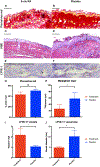Prevention of postsurgical lymphedema via immediate delivery of sustained-release 9-cis retinoic acid to the lymphedenectomy site
- PMID: 31240729
- PMCID: PMC6930358
- DOI: 10.1002/jso.25587
Prevention of postsurgical lymphedema via immediate delivery of sustained-release 9-cis retinoic acid to the lymphedenectomy site
Abstract
Background and objectives: Previously, we have shown that 9-cis retinoic acid (9-cis RA) stimulates lymphangiogenesis and limits postsurgical lymphedema in animal models when administered via daily intraperitoneal injections. In this study, we investigate whether a single-use depot 9-cis RA drug delivery system (DDS) implanted at the site of lymphatic injury can mitigate the development of lymphedema in a clinically relevant mouse limb model.
Methods: Hind limb lymphedema was induced via surgical lymphadenectomy and irradiation. Animals were divided into two treatment groups: (1) 9-cis RA DDS, (2) placebo DDS. Outcomes measured included paw thickness, lymphatic clearance and density, epidermal thickness, and collagen deposition.
Results: Compared with control animals, 9-cis RA-treated animals had significantly less paw swelling from postoperative week 3 (P = .04) until the final timepoint at week 6 (P = .0007). Moreover, 9-cis RA-treated animals had significantly faster lymphatic clearance (P < .05), increased lymphatic density (P = .04), reduced lymphatic vessel size (P = .02), reduced epidermal hyperplasia (P = .04), and reduced collagen staining (P = .10).
Conclusions: Animals receiving 9-cis RA sustained-release implants at the time of surgery had improved lymphatic function and structure, indicating reduced lymphedema progression. Thus, we demonstrate that 9-cis RA contained within a single-use depot DDS has favorable properties in limiting pathologic responses to lymphatic injury and may be an effective strategy against secondary lymphedema.
Keywords: 9-cis retinoic acid; depot; drug delivery system; drug pellet; lymphangiogenesis; lymphedema; postsurgical lymphedema; retinoic acid; secondary lymphedema; sustained release.
© 2019 Wiley Periodicals, Inc.
Conflict of interest statement
Disclosures
The authors have no conflicts of interest to disclose in relation to the contents of this manuscript.
Figures






Similar articles
-
Review of treatment strategies after lymphadenectomy: From molecular therapeutics to immediate microsurgical lymphatic reconstruction.J Vasc Surg Venous Lymphat Disord. 2024 Sep;12(5):101844. doi: 10.1016/j.jvsv.2024.101844. Epub 2024 Feb 3. J Vasc Surg Venous Lymphat Disord. 2024. PMID: 38316291 Free PMC article. Review.
-
Prevention of Postsurgical Lymphedema by 9-cis Retinoic Acid.Ann Surg. 2016 Aug;264(2):353-61. doi: 10.1097/SLA.0000000000001525. Ann Surg. 2016. PMID: 26655920 Free PMC article.
-
Prolymphangiogenic Effects of 9-cis Retinoic Acid Are Enhanced at Sites of Lymphatic Injury and Dependent on Treatment Duration in Experimental Postsurgical Lymphedema.Lymphat Res Biol. 2022 Dec;20(6):640-650. doi: 10.1089/lrb.2021.0073. Epub 2022 May 17. Lymphat Res Biol. 2022. PMID: 35584281 Free PMC article.
-
Lymphatic endothelial cell RXRα is critical for 9-cis-retinoic acid-mediated lymphangiogenesis and prevention of secondary lymphedema.FASEB J. 2023 Jan;37(1):e22674. doi: 10.1096/fj.202200146RR. FASEB J. 2023. PMID: 36520015
-
Lymphedema Incidence After Axillary Lymph Node Dissection: Quantifying the Impact of Radiation and the Lymphatic Microsurgical Preventive Healing Approach.Ann Plast Surg. 2019 Apr;82(4S Suppl 3):S234-S241. doi: 10.1097/SAP.0000000000001864. Ann Plast Surg. 2019. PMID: 30855393 Review.
Cited by
-
Lymphatic Tissue Bioengineering for the Treatment of Postsurgical Lymphedema.Bioengineering (Basel). 2022 Apr 6;9(4):162. doi: 10.3390/bioengineering9040162. Bioengineering (Basel). 2022. PMID: 35447722 Free PMC article. Review.
-
A Pre-clinical Animal Model of Secondary Head and Neck Lymphedema.Sci Rep. 2019 Dec 4;9(1):18264. doi: 10.1038/s41598-019-54201-2. Sci Rep. 2019. PMID: 31797883 Free PMC article.
-
Management of genital hidradenitis suppurativa and lymphoedema with the restoration of erectile function.Australas J Dermatol. 2022 May;63(2):e184-e186. doi: 10.1111/ajd.13796. Epub 2022 Feb 9. Australas J Dermatol. 2022. PMID: 35138636 Free PMC article. No abstract available.
-
Review of treatment strategies after lymphadenectomy: From molecular therapeutics to immediate microsurgical lymphatic reconstruction.J Vasc Surg Venous Lymphat Disord. 2024 Sep;12(5):101844. doi: 10.1016/j.jvsv.2024.101844. Epub 2024 Feb 3. J Vasc Surg Venous Lymphat Disord. 2024. PMID: 38316291 Free PMC article. Review.
-
Molecular pathophysiology of secondary lymphedema.Front Cell Dev Biol. 2024 Jul 8;12:1363811. doi: 10.3389/fcell.2024.1363811. eCollection 2024. Front Cell Dev Biol. 2024. PMID: 39045461 Free PMC article. Review.
References
-
- Rockson SG, Rivera KK (2008) Estimating the population burden of lymphedema. Ann N Y Acad Sci 1131: 147–154. - PubMed
-
- Shih YC, Xu Y, Cormier JN, Giordano S, Ridner SH, et al. (2009) Incidence, treatment costs, and complications of lymphedema after breast cancer among women of working age: a 2-year follow-up study. J Clin Oncol 27: 2007–2014. - PubMed
-
- Dellon AL, Hoopes JE (1977) The Charles procedure for primary lymphedema. Long-term clinical results. Plast Reconstr Surg 60: 589–595. - PubMed
-
- Szuba A, Skobe M, Karkkainen MJ, Shin WS, Beynet DP, et al. (2002) Therapeutic lymphangiogenesis with human recombinant VEGF-C. FASEB J 16: 1985–1987. - PubMed
MeSH terms
Substances
Grants and funding
LinkOut - more resources
Full Text Sources
Other Literature Sources
Medical

